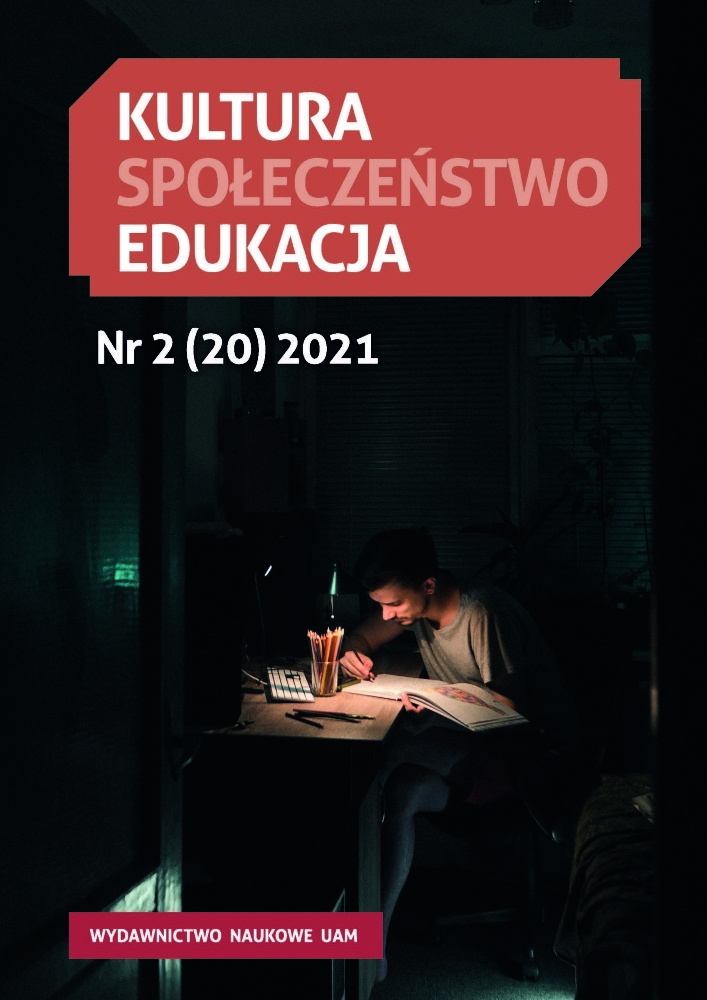Abstrakt
The aim of this article is to present the threats and opportunities in the fields of education and the professional situation of Moroccans, especially young people who both try to find their place on the local labor market and emigrate mainly to Western European countries, largely to France, Spain and Italy, seeking stabilization. The recent reforms and unilateral or multilateral initiatives of international consortia, governments, agencies, and non-governmental organizations operating globally and locally are a chance to create a most stable labor market for young people. Often these are micro-scale activities, but the activation and professional support on a micro scale may translate into the effects of improving quality on a macro scale, throughout the country. This article was prepared on the basis of international reports of OECD (Organisation for Economic Cooperation and Development), UNESCO, EU national studies, articles and press reports as well as information on the home pages of institutions and organizations such as USAID (United States Agency for International Development) or NED (The National Endowment for Democracy)
Bibliografia
Akinou M. (2021), Tamazight, an Official Language of Morocco, Is Getting More Attention, AL-FANAR MEDIA, Covering Education, Research and Culture, https://www.al-fanarmedia.org/2021/10/tamazight-an-official-language-of-morocco-is-getting-more-attention/, dostęp: 19.10.2021.
Arab Human Development Report (2016), Youth and the Prospects for Human Development in a Changing Reality UNDP, https://arab-hdr.org/report/youth-2016/, dostęp: 19.10.2021.
Chatri A., Chahbi O., Snihji M. (2021), The multilevel analysis of students’ achievement: Evidence from Morocco, African Development Review, 33, s. 117−129, https://onlinelibrary.wiley.com/doi/epdf/10.1111/1467-8268.12497, dostęp: 19.10.2021.
Chauffour J.-P. (2018), Morocco 2040. Emerging by Investing in Intangible Capital, Direction In Development. Countries and Regions, World Bank, https://openknowledge.worldbank.org/bitstream/handle/10986/28442/9781464810664.pdf?sequence=2&isAllowed=y, dostęp: 16.10.2021.
Enhancing Youth Employability, USAID, News and Information (2020), https://www.usaid.gov/morocco/fact-sheets/employability-youth-enhanced, dostęp: 18.10.2021.
Guessous H. (2019), PISA: Moroccan Students Have Poor Reading, Math, Science Abilities, Morocco World News, 03.12.2019, https://www.moroccoworldnews.com/2019/12/288097/pisa-moroccan-students-math-science, dostęp: 03.04.2021.
Ibourk A. (2013), Determinants of educational Achievement in Morocco: A Micro-Econometric Analysis Applied to The PIRLS Study, Regional and Sectoral Economic Studies, 13(2), s. 179–190, https://www.usc.gal/economet/reviews/eers13213.pdf, dostęp: 18.10.2021.
Johnsson E. (2018), Edukacja w Maroku w kontekście różnorodności społecznej i językowej, [w:] A. Boroń, A. Mańkowska, C. Czech-Włodarczyk, P. Peret-Drążewska (red.), Edukacja w warunkach globalnych i lokalnych. Konteksty i egzemplifikacje, Poznań.
Johnsson E. (2021), Dzieciństwo w Maroku, Studia Edukacyjne, 60, s. 177–197, https://doi.org/10.14746/se.2021.60.10.
Kabbani N., Kothari E. (2005), Youth Employment in the MENA Region: A Situational Assessment, World Bank SP Discussion Paper, 0534, Washington DC.
La situation du marché de travail au deuxième trimestre de 2021, Le Haut-Commissariat au Plan (2021), Notes d’information, https://www.hcp.ma/La-situation-du-marche-du-travail-au-deuxieme-trimestre-de-2021_a2739.html, dostęp: 19.10.2021.
Lahlou M. (2018), Migration Dynamics In Play In Morocco: Trafficking and Political Relationships and Their Implications at the Regional Level, MENARA Working Papers, 26, EU, https://www.iai.it/sites/default/files/menara_wp_26.pdf, dostęp: 19.10.2020.
Lopez-Acevedo G., Betcherman G., Khellaf A., Molini V. (2021), Morocco’s Jobs Landscape Identifying Constraints to an Inclusive Labor Market, International Development in Focus, The World Bank, [pdf], https://www.worldbank.org/en/country/morocco/publication/morocco-jobs-landscape, dostęp: 19.10.2021.
Mansuy M., Werquin P. (2018), Moroccan youth and employment: gender differences, Journal of Education and Work, 31, 5−6, s. 545−562, https://doi.org/10.1080/13639080.2018.1541504.
MENA, Middle East & North Africa, The World Bank, 2021, https://data.worldbank.org/country/ZQ, dostęp: 10.10.2021.
Morocco, Education and Literacy, General Informations, UNESCO, 2019, http://uis.unesco.org/country/MA, dostęp: 06.10.2021.
Morocco, Education and Literacy, Illiterate Population, 2018, http://uis.unesco.org/country/MA, dostęp: 06.10.2021.
Morocco, Education and Literacy, Literacy Rate, 2018, http://uis.unesco.org/country/MA, dostęp: 06.10.2021.
Morocco, Education and Literacy, Participation in Education, UNESCO, 2020, http://uis.unesco.org/country/MA, dostęp: 06.10.2021.
NED Grantees Support Youth Civil Society Organizations In Morocco, published on August 12, 2021, https://www.ned.org/ned-grantees-support-youth-civil-society-organizations-in-morocco/, dostęp: 18.10.2021.
Paciello M.C., Pepicelli R., Pioppi D. (2016), Power 2 Youth, Public Action towards Youth in NeoLiberal Morocco: Fostering and Controlling the Unequal Inclusion of the New Generation, Istituto Affari Internazionali (IAI), Working Paper, 5, https://core.ac.uk/download/pdf/267979819.pdf, dostęp: 19.20.2021.
Parole aux Jeunes, Association Les Citoyens (2019), https://shabablive.com/en/partner/associationles-citoyens/, dostęp: 19.10.2021.
Parole aux Jeunes, Association Les Citoyens (2020), https://www.euneighbours.eu/en/south/stay-informed/news/giving-youth-voice-new-eu-funded-media-projectmorocco, dostęp: 20.10.2021.
PISA, The Programme for International Student Assessment, Results from PISA 2018, Country Note Morocco (2019), Key features of PISA 2018, OECD, Volumes I−III, s. 1−8, https://www.oecd.org/pisa/publications/PISA2018_CN_MAR.pdf, s. 1−8, dostęp: 19.10.2021.
Poeschel F., Levionnois Ch. (2017), Talent Abroad: A Review of Moroccan Emigrants, OECD, https://www.oecd-ilibrary.org/social-issues-migration-health/talent-abroad-a-review-of-moroccanemigrants_9789264264281-en, dostęp: 18.10.2021.
Radi A. (2017), Protest Movements and Social Media: Morocco’s February 20 Movement, Africa Development/Afrique et Développement, 42, 2, Special Issue on Study on Oblique Identity Dynamics/Numéro spécial sur l’Étude des dynamiques identitaires obliques CODESRIA, 2017.
Ridker R.G. (1997), Determinants of Educational Achievement and Attainment in Africa, Findings from Nine Case Studies, SD Publication Series Office of Sustainable Development Bureau for Africa Technical Paper, August, 62, Health and Human Resources Analysis for Africa Project, USAID, https://pdf.usaid.gov/pdf_docs/PNACA323.pdf, dostęp: 20.10.2021.
Snijder M. (2015), Youth work in Morocco and youth participation projects at local level, Salto-Youth, EU, EUROMED, https://www.salto-youth.net/downloads/4-17-3140/def_p_1−40_youth_work_morocco.pdf, dostęp: 19.10.2021.
Śliwerski B. (2016), Krytycznie o metodologicznych przesłankach udziału naukowców w Międzynarodowym Programie PISA/OECD, Studia Edukacyjne, 38, s. 21–42.
USAID (2020), Enhancing Youth Employability, https://www.usaid.gov/morocco/fact-sheets/employability-youth-enhanced, dostęp: 18.10.2021.
Zhao Y. (2020), Two decades of havoc: A synthesis of criticism against PISA, Journal of Educational Change, 21, s. 245–266, https://doi.org/10.1007/s10833-019-09367-x.
Licencja
Prawa autorskie (c) 2021 Ewa Johnsson

Utwór dostępny jest na licencji Creative Commons Uznanie autorstwa – Bez utworów zależnych 4.0 Międzynarodowe.

